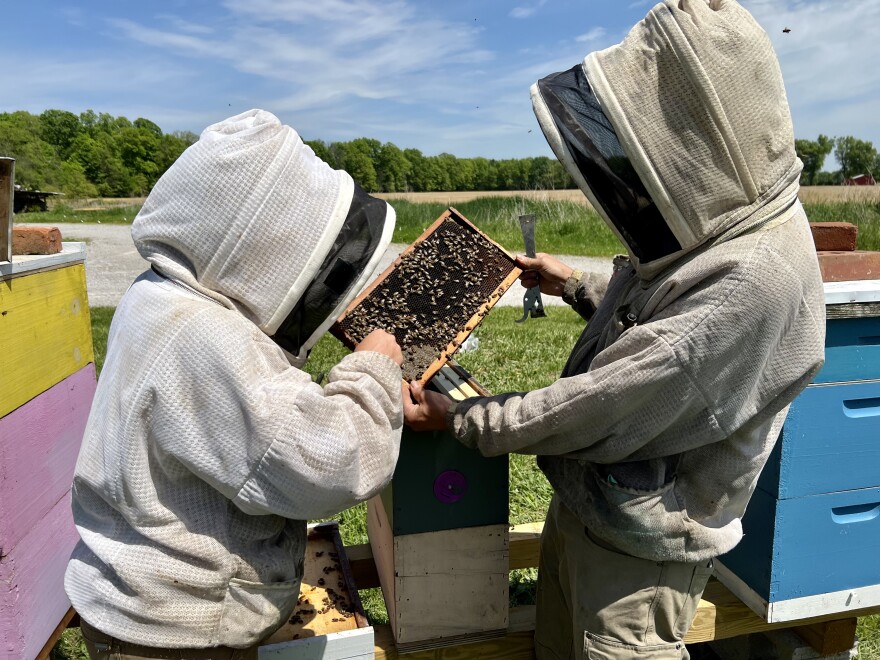Kevin and Liz Jones walk slowly toward one of the brightly colored wooden boxes that line the yard of their farm in Batavia, just east of Cincinnati.
Each box holds around 60,000 bees, working to make honey. The Joneses, who have been the owner of HappBee Acres Bee Supply for the last two years, are checking in on their progress. Puffs of smoke waft from a metal tool in Liz’s hand. It calms the bees, she said.
“So, the bees that do see us come up don't make everybody else upset,” Liz said.
In white veiled caps, they work together to slide out a frame, covered in a jumble of buzzing bees. The colony has been pollinating nearby flowers.
“See the glistening inside those cells?” she said. “All of that is spring honey. So that'll all be from honeysuckle, dandelions, black locusts starting to bloom.”

Ohio’s honey production is on the rise. Last year, the state saw a more than 20% jump in commercially produced honey. And, commercial hives aren’t the only ones that are growing: More and more Ohioans are becoming hobbyists, or “backyard beekeepers.”
Welcoming new-bees
Once a month, Kevin and Liz take people from across the state on inspections of honeybee colonies. They offer free beginner beekeeping classes, which have grown rapidly in attendance. Their last class had 50 people, some from as far as two hours away.
“We have concrete truck drivers and janitors and heart surgeons and lawyers,” Kevin said. “There's not any one larger percentage of people than the other that are interested in keeping bees.”
Around 7,000 beekeepers across the state care for more than 50,000 colonies. Last year, 500 Ohioans decided to suit up for the first time and start keeping bees.
“A third of everything that we bite into, all of our food, benefit from honeybees."Barbara Bloetscher, state apiarist
Liz said many people tell her that during the COVID-19 pandemic, they started thinking harder about the food they eat — and the ecosystem behind it.
“And if this one box of bugs can give you more than just honey — they give you the pollination in your garden, they make your strawberries bloom better, all of these different things — then why not do it?” she said.
More than just honey
But, the trend started with an even earlier crisis: colony collapse disorder. In 2006, varroa mites began killing off colonies. By 2010, Ohio had lost more than half of its honeybee population.
State apiarist Barbara Bloetscher said since the sharp decline, Ohio has seen a steady climb of beekeepers every year. She thinks that’s partly due to a campaign to save the bees.

Bloetscher said more people became aware of bees’ role in our ecosystem. They learned it’s not just about honey, it’s about what the bees pollinate and their impact on the larger food chain.
“A third of everything that we bite into, all of our food, benefit from honeybees,” she said.
Keeping busy
Even with more people interested in raising honeybees, the state is a long way from its peak. In the 1940s, Ohio was one of the top four states for honey production. Now, it ranks 23rd.

“We do have some younger generations that are going into beekeeping, which is very exciting,” Bloetscher said. “But I don't know if we're ever going to reclaim our kingdom.”
If Ohio does, it’ll be thanks to people like Kevin and Liz, who are showing dozens of Ohio’s newest beekeepers the ropes. Liz gets excited each time she can share the calming experience of tending to a hive.
“The only sound you can hear is the bees buzzing,” she said. “It just makes life peaceful for the time that you are in a colony.”
The Jones’ shop has a different kind of buzz. The couple can hardly keep up with the amount of people who come through their doors, looking for equipment or advice on how to get started.
They’re busy. As busy as a… Well, you get the idea.


